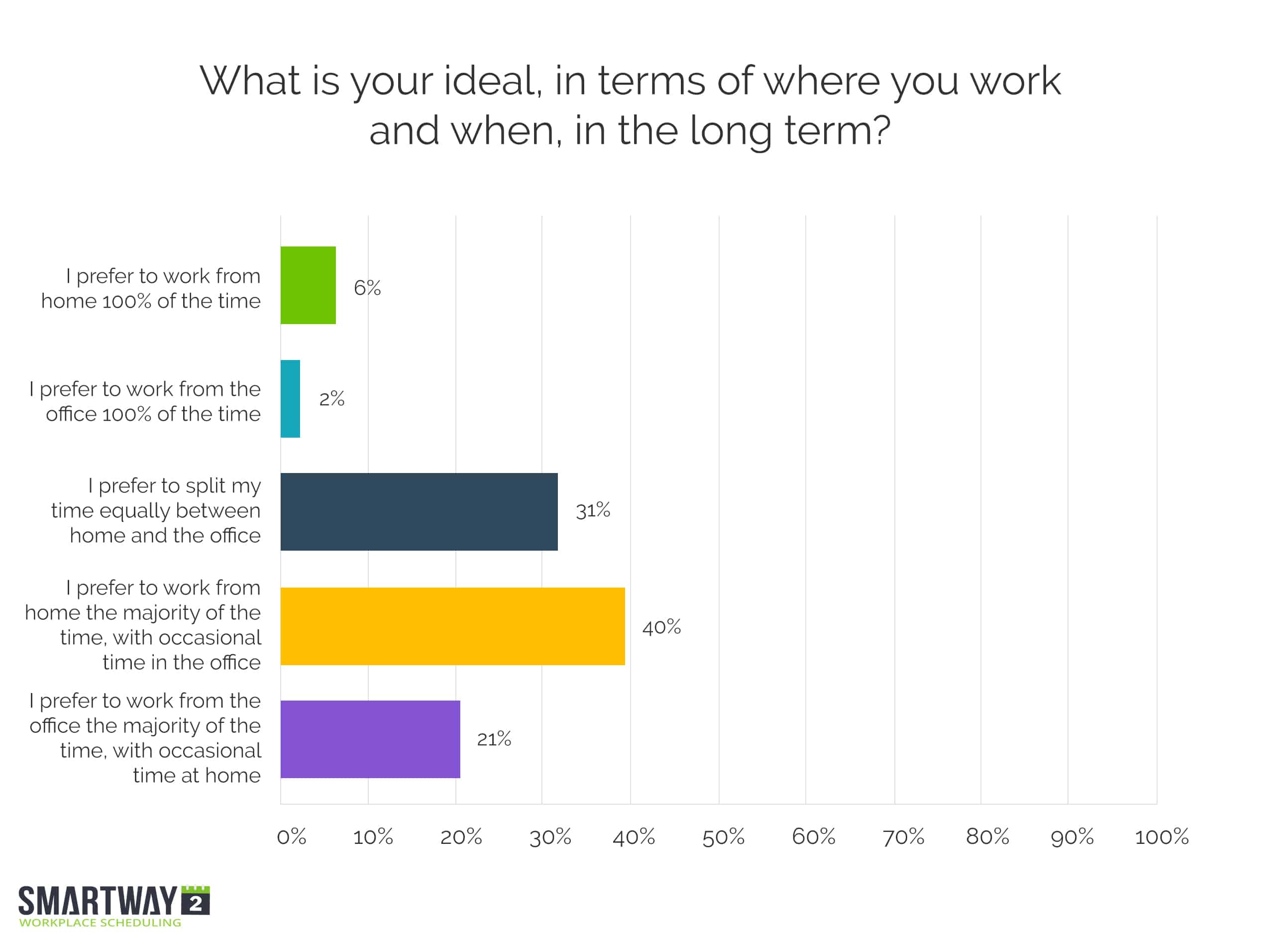
Hybrid Work: How Will It Transform Your Business?
Today you’re going to learn precisely what Hybrid Work is and how it can transform your business in 2022.
What is it? And is it here to stay? Those are two major questions swirling around the business community as the organizations find the best working policy post-pandemic.
What is a Hybrid Work model?
Hybrid work entails employees working both from an office and from home. Typically, it involves a certain level of flexibility, allowing employees to pick and choose where and when they get their job done.
According to Gartner, “Hybrid workforce planning is a deliberate design that enables employees to flow through various work sites — from remote solo locations and microsites of small populations to traditional concentrated facilities (offices, factories, retail, etc.).”
The key to a successful experience is flexibility. Employees get the best of both worlds – remote work and at the office – by determining how, when and where they, individually, work best.

What are the benefits of a Hybrid Work model?
There are numerous benefits to a hybrid work model. A few of the immediate advantages we have found center around flexibility, increased productivity and the ability to cut costs after re-assessing office needs.
Leading global technology company Barco writes, “Not only will hybrid work-models help businesses to remain agile and give them the ability to adapt quickly to unexpected circumstances to keep their operations running in these especially uncertain times, the new models also have some clear benefits for the well-being and productivity of their employees…”
According to Barco, it includes the following 5 benefits:
1. Public health – Barco explains that hybrid work environments help to keep employees safe. When people do go back to work, the office is less populated and social distancing policies need to be put in place. While improving sanitary working conditions has become a heightened focus during the pandemic, public health benefits of hybrid work also come into play for other contagious ailemtns such as the common cold, flu, or any other virus is prevalent among employees.
2. Productivity – Barco cites hybrid work environments as enabling companies to share technology with employees remotely that they usually only provide within the office. This equips employees with on-demand technology access when they need it so they can accomplish work from somewhere other than the office.
3. Collaboration – By re-introducing some office work into the equation, employees are naturally able to get the social interaction they crave and foster collaboration that has been difficult during the pandemic while most people have worked remotely.
4. Work-Life Balance – Being able to pick and choose work environments can help to relieve stress. Barco writes, “There is time for focused work, decision-making, intense meeting and following seminars, but also for spending time with family, helping the kids with homework, walking the dog or taking that yoga class.”
5. Save Time – Hybrid work means people can reduce commuting times by setting a schedule based on what works for their individual circumstances rather than relying on a conventional 9-5 approach.
This BBC article includes multiple companies that share some other crucial advantages of hybrid work: “It tends to include more freedom around when to work as well as where. It generally grants more autonomy to employees to fit work around the rest of their lives, rather than structuring other parts of a weekday around hours logged in an office. Ideally, it’s the best of both worlds: structure and sociability on one hand, and independence and flexibility on the other.
Furthermore, a recent Boston Consulting Group article adds, “Hybrid work models, done right, will allow organizations to better recruit talent, achieve innovation, and create value for all stakeholders. By acting boldly now, they can define a future of work that is more flexible, digital, and purposeful.”
One of the other benefits of enacting this kind of work strategy is that employees feel empowered, as their needs are being put first. Recruiter.com writes, “Hybrid work models also show employees that their employer is prioritizing their well-being above all else. That’s an extremely important message to send if you want to keep your company culture alive and well throughout the rest of the pandemic For many, life is difficult right now, and there are things going on in the world outside of our control. This kind of model can ease some of that burden, allowing employees to tend to personal responsibilities while still handling their work-related duties.”

The Data
Research supports the idea that people have no interest in going back to the way work schedules were before COVID-19. So, what does that mean? Here’s a breakdown of some recent findings:
Most people do not want to work from the office full-time, but they also don’t want to work from home full-time.
Smartway2 research found that 90% of survey respondents would like to do a combination of remote and in office work. Just 2% said that they would like to work from the office all the time and just 6% said they want to work from home all the time.

Research from Cisco found that 77% of larger organizations will increase work flexibility moving forward. Cisco’s numbers also show that 53% of organizations will shrink the size of their offices. For those returning to the office in some capacity, the data from Cisco shows that 97% of employees want their employers to make safety changes, with the top requests including sanitation and social distance enforcement.
Mirroring the research we have already mentioned, a Stanford study conducted in May found that a majority (55%) of U.S. workers want a mixture of home and office work.
Managing a Hybrid Workforce
In order to manage this kind of workforce, workplace scheduling tools are key.
Why, might you ask, is workplace scheduling so important?
Ultimately, you can’t have 80% of employees deciding to head into the office on Monday, with only 10% coming in on Tuesday – as this kind of uneven use creates huge waste and inefficiencies.
If you use a workplace scheduling system like Smartway2, employees can book a desk or conference room in advance. This is helpful and important for multiple reasons including the following:
- Ensures workers have somewhere to go when they come into the office. This cuts down on wasted time and any stress regarding a shared-desk system. This can also help to make sure workers have the proper tech and tools they need when they do decide to come into work.
- Allows managers to understand what type of space they need and how to best organize it. This also lets leaders see who wants to come into the office and when.
- Enables you to automate a safe return to work, including social distancing and sanitizing measures to keep office clean and safe amid the pandemic.

Successful Application
In order to create a successful hybrid work environment it is important to put proper guidelines in place for your employees so that they fully understand what is required of them. Brimstone Consulting emphasizes that point by writing, “For organizations to successfully transition to remote work or to a hybrid model, infrastructure must be put in place. This means ensuring employees have the technology and supplies needed to be productive.”
There are of course many other things that a company can do to make this type of work environment a success. A recently published Forbes article takes a look at it in the UK. The article specifically points to 3 key areas for leaders to focus on: open communication, trust and empathy.

Related Concepts
There are many related concepts to Hybrid work that are important for you to understand in order to fully grasp how it works.
Agile Work: Agile working is all about choice. It involves letting employees choose how, when and where they do their job. This typically involves a work environment in which there are multiple options for employees to pick and choose depending on what type of work they have at a given point in time.
Flexible Work: Flexible work is a wide-ranging term used to describe any type of work schedule that enables employees to organize their time outside the bounds of conventional 9-5 working in the office.
Distributed Work: Distributed work describes a workplace where employees within the company get their work done in different physical locations.
Smartway2 is a next-generation workplace scheduling platform for modern, agile and collaborative companies. Our flexible software enables organizations to increase productivity, optimize space utilization and automate a safe return to the office.
To find out more about our Workplace Scheduling software check out our free webinars.


